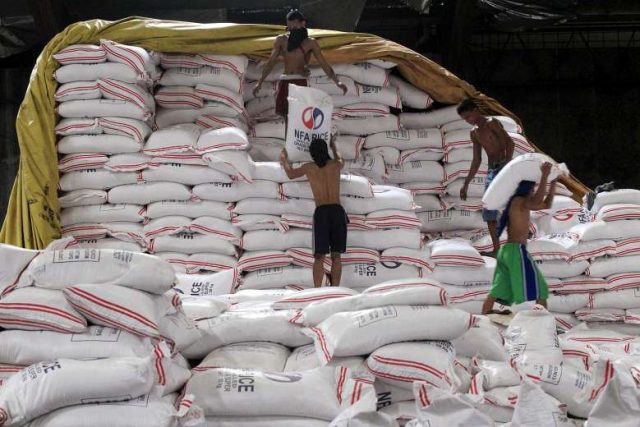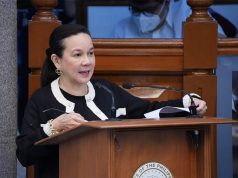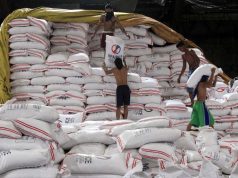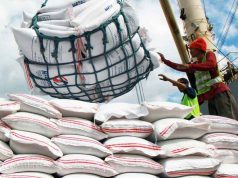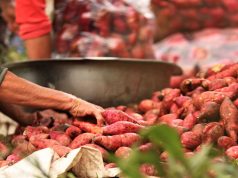MANILA – Agriculture Secretary Manny Piñol is out to prove that unscrupulous parties are distorting the market situation, thus causing the “shortage” of the affordable rice bought by the National Food Authority from farmers and sold at prices much lower than commercial rice.
Similar suspicions were aired Wednesday by Sen. Grace Poe, who sought a full Senate inquiry on the tell-tale signs that the shortage was contrived by syndicates, and gaps in the NFA’s buying and distribution operations were making it possible for unscrupulous traders to manipulate the market.
On Wednesday, people flocked to the DA offices where cheap rice was being sold, in Piñol’s bid to prove his point. The equivalent of commercial rice sold at P48 a kilo went only for P38 at DA.
One was allowed to buy as much as 25 kilos.
Meann Manguera, one of those who buys five kilos of rice on average weekly for her family, took the opportunity to buy cheap rice and bought 20 kilos.
“I saw the rice–it’s worth it. Quality is good, but the price is reasonable. I hope they always offer this,” said Manguera.
The DA explained that by making such rice available, it wanted to prove that affordable rice is still available in the market, especially if it’s bought directly from the farmers. It’s important, DA said, to prevent traders and middlemen from controlling the price from the farm to the markets.
In Piñol’s view, there’s something wrong in the distribution system of the NFA rice, and this accounts for the shortage in its buffer stock. His agency thus thinks the government should control the rice industry.
“[There are many] instances where the NFA rice is being sold to favored wholesalers,” said Piñol, adding that these wholesalers are the ones who re-pack and re-sell the NFA rice, that is why the impact in the countryside is very limited.
The merchants control everything, Piñol lamented. They decide, they re-bag and re-sack what should have been sold low and instead sell this as commercial rice. As expected, it will not lower prices in the market, he added.
NFA COUNCIL ISSUES RESOLUTION
Investigating the rice traders is not part of the DA’s mandate, but the NFA Council has already issued a resolution to audit the NFA, from its acquisition down to its distribution practice, said DA Undersecretary Ariel Cayanan.
The NFA said it is open to an investigation. Atty Rachel Miguel, NFA Administrator Jason Aquino’s special assistant, said: “Yes, the NFA management welcomes the audit [in order to clarify the] issues as to our distribution. She noted the different distribution levels in the provinces and island municipalities, because the daily consumption requirements (DCR) vary. “And some are palay procuring, some are not. Also, [some] provinces [have a high] poverty incidence like the NCR, so [their] distribution area is big.”
Meanwhile, the DA noted the country produced over 19 million metric tons of rice in 2017 – driving expectations that the rice sufficiency target can be met in 2020.
“In the history of rice industry in the country, this was the highest production,” said Piñol. The production of palay is already above and beyond the national requirement but were not declaring rice sufficiency as of yet.” Officially, the Philippines is 96% rice sufficient, he said.
Still, Piñol conceded that while self-sufficiency may be reached, that status may be maintained only for 10 years owing to the ballooning population.
The DA is now partnering with Papua New Guinea so that some Filipinos can plant rice in that country, and supply rice there. Any excess from the Filipinos’ production in PNG can be exported to the Philippines.
‘BEWILDERING’ LOW STOCK AMID SURPLUS: POE
Also on Wednesday, Sen. Grace Poe weighed in on the matter of data not adding up in the rice supply, pushing for a Senate probe of the “downright bewildering” critically low supply of affordable rice on the back of a record-breaking surplus in the supply of the staple.
Poe urged the Senate to launch an investigation into long-standing claims that there exists a syndicate in the NFA that manipulates rice data.
Poe filed Senate Resolution No. 623 directing the Senate Committee on Agriculture and Food chaired by Sen. Cynthia Villar to investigate the purported shortage of affordable rice that is driving up prices of commercial rice sold in the markets.
“It is downright bewildering to allegedly have a record-breaking surplus in rice supply on one hand and experience a low inventory of rice in the warehouses of NFA on the other hand and thereby needing to import rice,” said Poe in filing the resolution.
Poe said a Senate inquiry could determine the veracity of “persistent allegations” of a mafia, syndicate or “rice cartel” in the government’s rice procurement and importation program. This was needed, she added, put an end to their illegal and corrupt practices and ensure the availability of the staple.
The Philippine Statistics Authority late last month said a total of 19.28 million metric tons of palay was produced in 2017, compared with 17.63 million metric tons in 2016, or a 9.36% increase.
Piñol earlier said he expects the Philippines to reach a record-breaking 3 million metric tons in the first quarter of 2018.
The NFA said stocks of cheap rice are running low. The agency also stopped supplying rice to local retailers, resulting in the unavailability of affordable rice in the market and the jacking up of prices of commercial rice.
Poe said, “we cannot turn a blind eye on alleged reports regarding the existence of a rice cartel in the Philippines.”
The inter-agency NFA Council on Monday approved the importation of 250,000 MT of rice mainly from Vietnam and Thailand, a move meant to replenish the dwindling buffer stock.
The NFA is mandated to maintain a 15-day buffer stock at any given time and 30 days at the onset of the lean months of July to September.

